inflation pressure AUDI A5 COUPE 2018 Owners Manual
[x] Cancel search | Manufacturer: AUDI, Model Year: 2018, Model line: A5 COUPE, Model: AUDI A5 COUPE 2018Pages: 409, PDF Size: 67.63 MB
Page 266 of 409
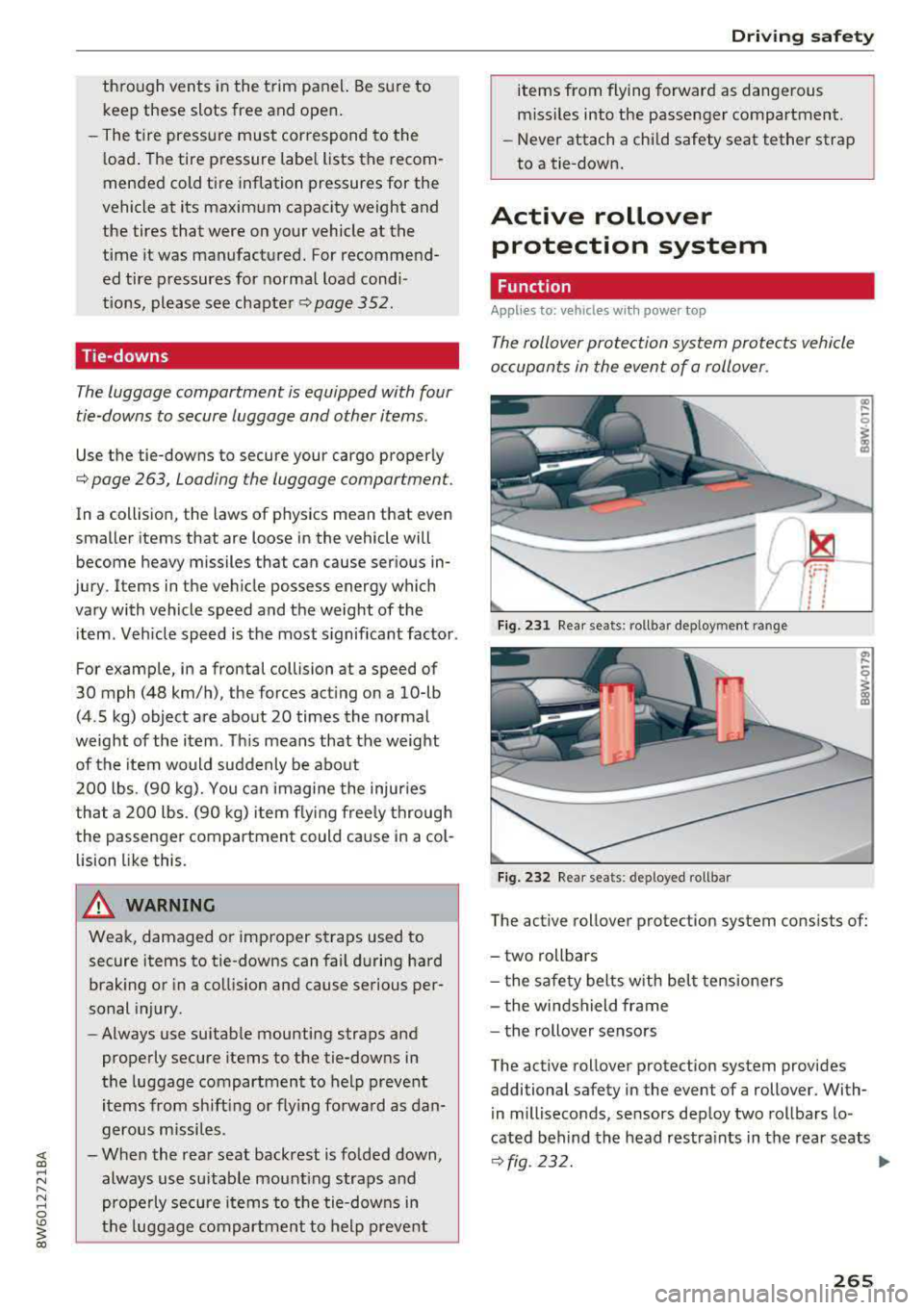
through vents in the trim panel. Be sure to keep these slots free and open .
- The t ire pressure must correspond to the
l oad . The tire pressure labe l lists the recom
mended cold tire inflation pressures for the
vehicle at its maximum capacity weight and
the tires that were on your vehicle at the
time it was manufactured. For recommend
ed tire pressures for normal load condi
tions, please see chapter
q page 3 52.
Tie-downs
The luggage compartment is equipped with four
tie-downs to secure luggage and other items .
Use the tie-downs to secure your cargo properly
q page 263, Loading the luggage compartment.
In a collision, the laws of physics mean that even
smaller items that are loose in the vehicle will
become heavy missiles that can cause serious in
jury . Items in the vehicle possess energy which
vary with vehicle speed and the weight of the
item . Veh icle speed is the most s ignificant factor .
For example, in a frontal collision at a speed of
30 mph (48 km/h), the forces acting on a 10-lb
(4.5 kg) object are about 20 times the normal
weight of the item . Th is means that the weight
of the item wo uld suddenly be abo ut
200 lbs . (90 kg). You can imagine the injuries
that a 200 lbs . (90 kg) item fly ing free ly through
the passenger compartment could cause in a col
lision l ike this .
A WARNING
Weak, damaged or improper straps used to
secure items to tie-downs can fail d uring hard
brak ing or in a collision and cause serious per
sonal injury.
- Always use su itab le mounting straps and
properly secure items to the tie-downs in
the luggage compartment to help prevent
items from shift ing or fly ing fo rwa rd as dan
gerous missiles.
- When the rear seat backrest is folded down, always use su itab le mount ing straps and
prope rly secure items to t he tie-downs in
the luggage compartmen t to help p reve nt
-
Dr iving safety
items from flying forward as dangerous
miss iles into the passenger compartment .
- Never attach a chi ld safety seat tether strap
to a tie-down.
Active rollover protection system
Function
Applies to: veh icles w ith power top
The rollover protection system protects vehicle
occupants in the event of a rollover .
Fig. 231 Rear seats : rollbar deployment range
Fig. 232 Rear seats : deployed rollbar
The active rollover protection system consists of:
- two rollbars
- t he safe ty belts with bel t tensione rs
- the wi ndshield frame
- the rollover senso rs
The active rollover protection system provides additional safety in the event of a rollover. With
i n milliseconds, sensors deploy two rollbars lo
cated behind the head restra ints in the rear seats
¢ fig . 232. 11iJJ,
265
Page 344 of 409
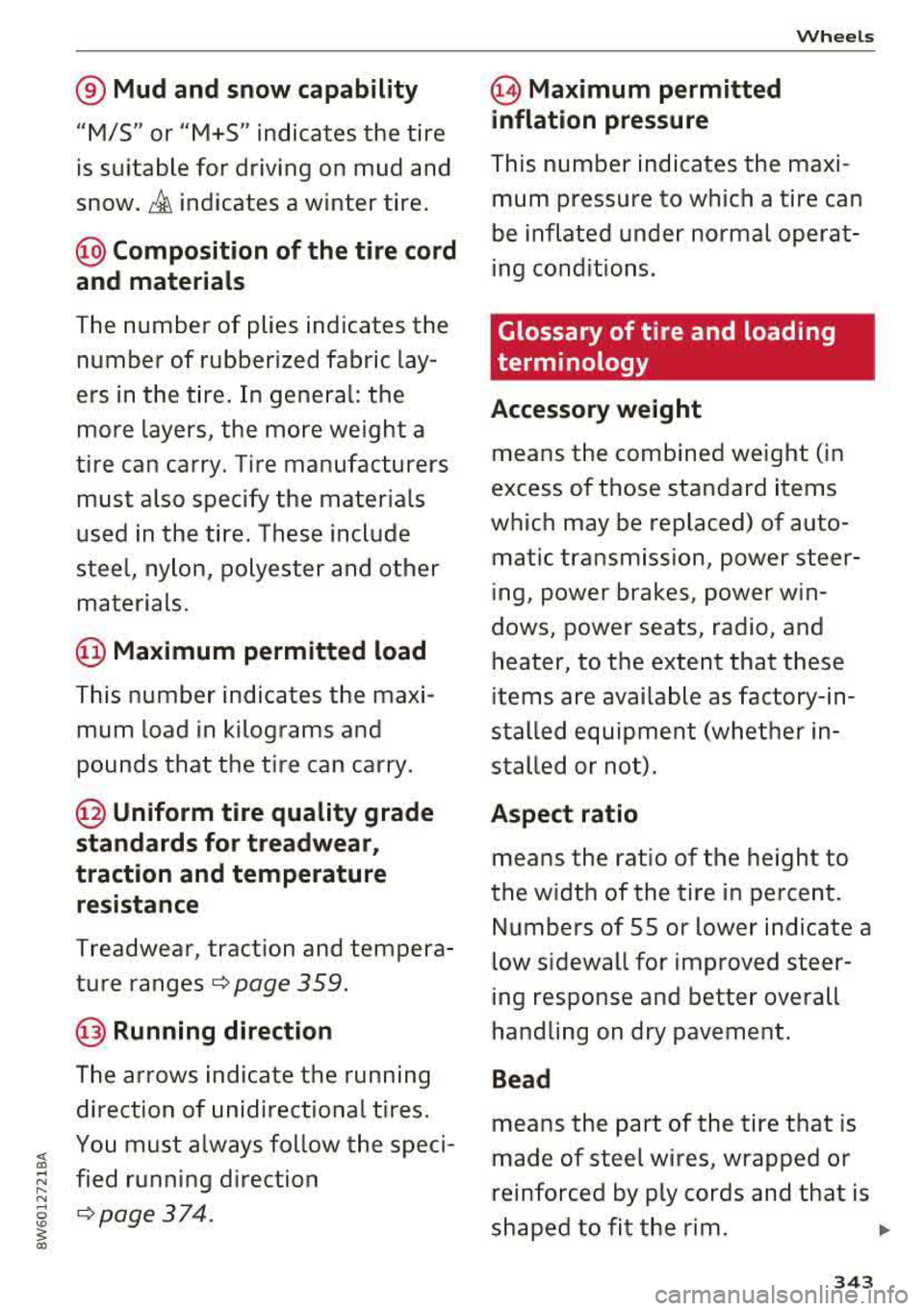
® Mud and snow capability
"M/5" or "M+S" indicates the tire
is suitable for driving on mud and
snow. £ indicates a winter tire.
@Composition of the tire cord
and materials
The number of plies indicates the
number of rubberized fabric lay
ers in the tire . In general: the
more layers, the more weight a
tire can carry. Tire manufacturers must also specify the materials
used in the ti re . These inc lude
stee l, nylon, polyester and other
materials.
@ Maximum permitted load
This number indicates the maxi
mum load in kilograms and
pounds that the tire can carry.
@ Un iform tire quality grade
standards for treadwear,
traction and temperature resistance
Treadwear, traction and tempera
ture
ranges¢ page 359.
@ Running direction
T he arrows indicate the running
direction of unidirectional tires.
You must always follow the speci
fied running direction
¢page 374.
~ Maximum permitted
inflation pressure
Wheels
T his number indicates the maxi
mum pressure to which a tire can
be inflated under normal operat
ing condit ions .
Glossary of tire and loading
terminology
Accessory weight
means the combined weight (in
excess of those standard items
which may be replaced) of auto matic t ransmission, power steer
ing, power brakes, power win
dows , powe r seats, radio, and
heater, to the extent tha t these
items are avai lab le as factory- in
stalled equipment (whether in
s t alled or not).
Aspect ratio
means the ratio of the height to
the w idth of the tire in percent.
Numbers of 55 or lower indicate a
low sidewall for improved steer
ing response and better overall
handling on dry pavement .
Bead
means the part of the tire that is
made of steel wires, wrapped or
reinfo rced by ply cords and that is
shaped to fit the rim.
...
3 4 3
Page 345 of 409
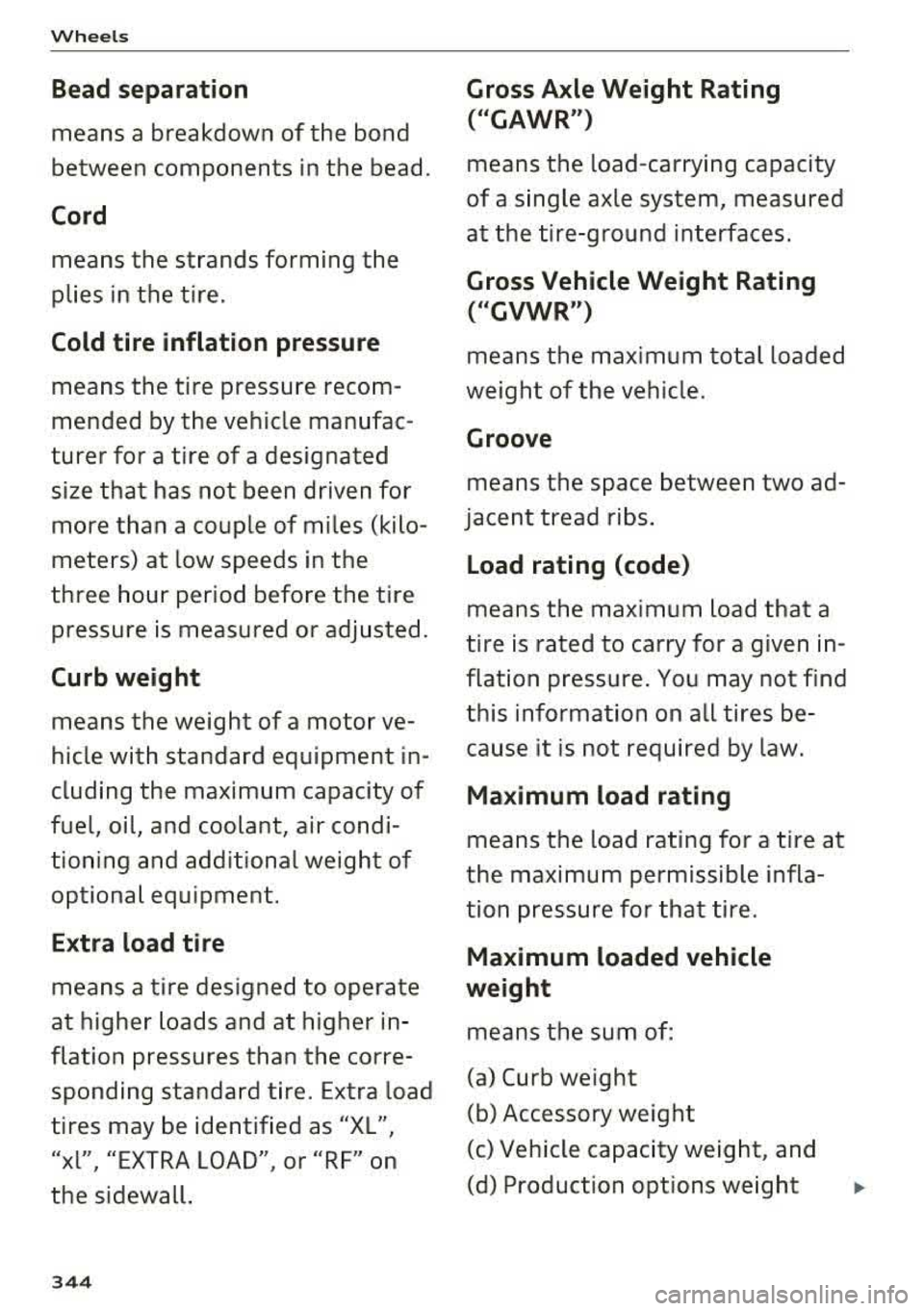
Wheel s
Bead separation
means a breakdown of the bond
between components in the bead .
Cord
means the strands forming the
plies in the t ire.
Cold tire inflation pressure
means the tire pressure recom
mended by the vehicle manufac
turer for a tire of a designated
size that has not been driven for more than a couple of miles (kilo
meters) at low speeds in the
three hour period before the tire
pressure is measured or adjusted.
Curb weight
means the weight of a motor ve
hicle with standard equipment in
cluding the maximum capacity of
fuel, oil, and coolant, air condi
tioning and additional weight of optional equipment.
E x tra load tire
means a tire designed to operate
at higher loads and at higher in
flation pressures than the corre sponding standard tire . Extra load
tires may be identified as
"XL",
"xl", "EXTRA LOAD", or "RF" on
the sidewal l.
344
Gross Axle Weight Rating
("GAWR ")
means the load-carrying capacity
of a single axle system, measured
at the tire -ground interfaces .
Gross Vehicle Weight Rating
(" GVWR ")
means the maximum total loaded
weight of the vehicle .
Groove
means the space between two ad
jacent tread ribs .
Load rating (code )
means the maximum load that a
tire is rated to carry for a given in
flation pressure. You may not find
this information on all tires be
cause it is not required by law.
Ma ximum load rating
means the load rating for a tire at
the maximum permissible infla tion pressure for that tire.
Ma ximum loaded vehicle
weight
means the sum of :
(a) Curb weight
(b) Accessory weight
(c) Vehicle capacity weight, and
(d) Production options we ight
Page 346 of 409
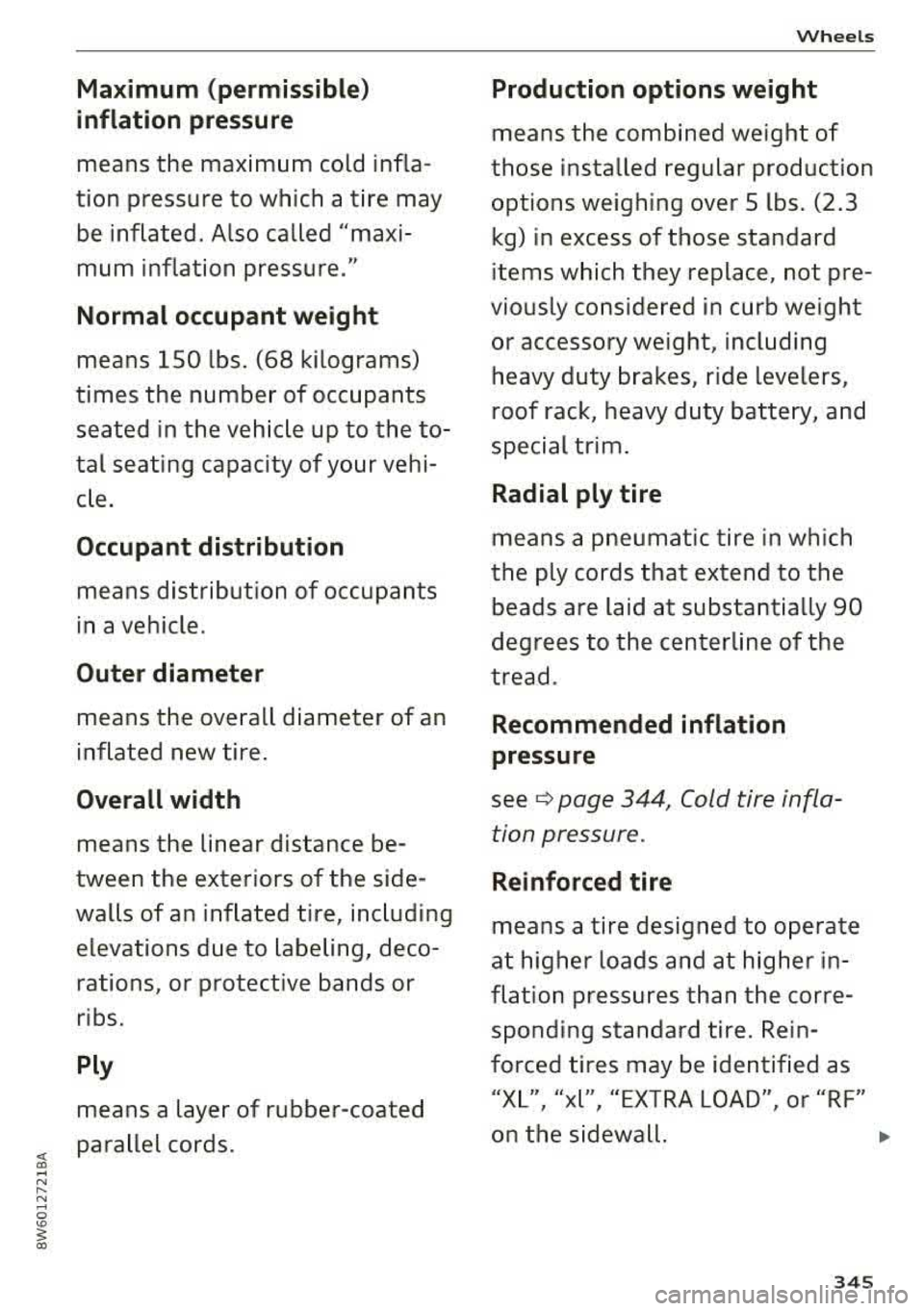
Maximum (permissible )
inflat ion pressure
means the maximum cold infla
tion pressure to wh ich a t ire may
be inflated . Also called "maxi
mum inflation pressure ."
Normal occupant weight
means 150 lbs . (68 kilograms)
times the numbe r of occupants
seated in the veh icle up to the to
tal seating capacity of your vehi
c le .
Occupant distribution
means distribution of occupants
in a vehicle .
Outer diameter
means the overall diameter of an
inflated new tire .
Overall width
means the linear dis ta n ce be
tween the exteriors of the side
walls of an inflated tire, inc luding
e levations due to labeling, deco
rations, or protect ive bands or
ribs.
Ply
means a layer of rubber-coated
parallel cords .
Wheels
Production options weight
means the combined weight of
those installed regular production
options weighing over 5 lbs. (2.3 kg) in excess of those standard
items which they replace, not pre
viously considered in curb weight
or accessory weight, including
heavy duty brakes, ride levelers,
roof rack , heavy d uty ba tte ry , and
special trim .
Radial ply tire
means a pneumatic tire in which
the ply cords that extend to the
beads are laid at substantia lly 90
degrees to the centerline of the
tread .
Recommended inflation
pressure
see ¢ page 34 4, Cold tire infla
tion pressure .
Reinforced tire
means a tire designed to operate
at higher loads and at higher in
fl at ion pressures than the corre
sponding standard tire. Rein
forced tires may be identified as
"X L", "x l", "EXTRA LOA D", or "RF"
on the s idewa ll.
..,
3 45
Page 357 of 409
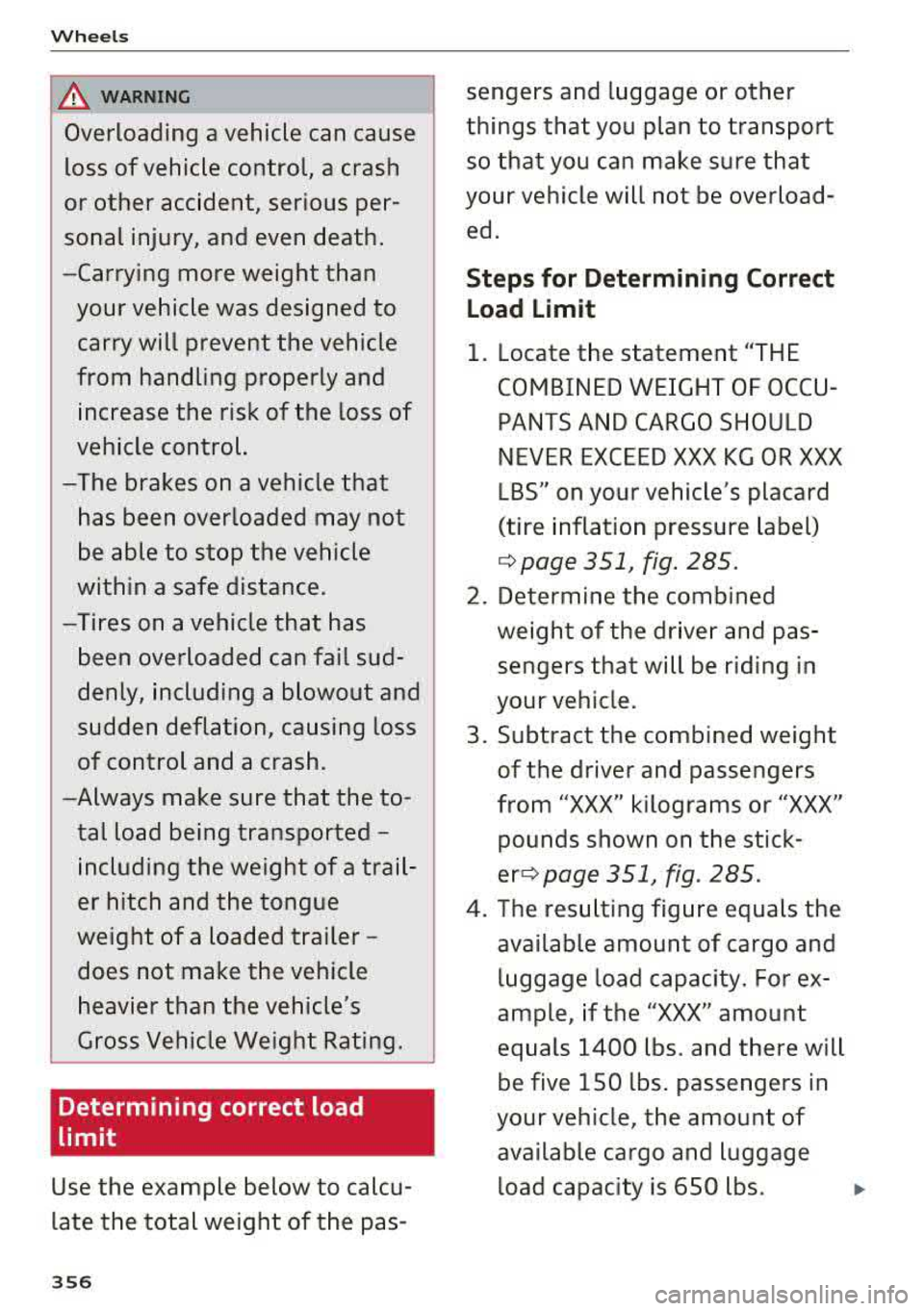
Wheels
A WARNING
Overloading a vehicle can cause
loss of vehicle control, a crash
or other accident, serious per
sonal injury, and even death.
-Carrying more weight than your vehicle was designed to carry will prevent the vehicle
from handling properly and
increase the risk of the loss of
vehicle control.
-The brakes on a vehicle that
has been overloaded may not
be able to stop the vehicle
within a safe distance.
-Tires on a vehicle that has
been overloaded can fail sud
denly, including a blowout and
sudden deflation, causing loss
of control and a crash.
-Always make sure that the to
tal load being transported
-
includ ing the weight of a trail
er hitch and the tongue
weight of a loaded trailer
-
does not make the vehicle
heavier than the vehicle's
Gross Vehicle Weight Rating.
Determining correct load
limit
Use the example below to calcu
late the total weight of the pas -
356
sengers and luggage or other
things that you plan to transport so that you can make sure that
your vehicle will not be overload
ed.
Steps for Determining Correct Load Limit
1. Locat e the statement "THE
COMBINED WEIGHT OF OCCU
PANTS AND CARGO SHOULD
NEVER EXCEED XXX KG OR XXX
LBS" on your vehicle's placard
(tire inflation pressure label)
Q page 351, fig. 285.
2.
Determine the combined
weight of the driver and pas
sengers that will be riding in
your vehicle.
3. Subtract the combined weight
of the driver and passengers
from
"XXX" kilograms or "XXX"
pounds shown on the stick
erQ page 351, fig. 285.
4. The resulting figure equals the
available amount of cargo and luggage load capacity. For ex
ample, if the "XXX" amount
equals 1400 lbs . and there will
be five 150 lbs. passengers in
your vehicle, the amount of
available cargo and luggage load capacity is 650 lbs.
.,.
Page 361 of 409
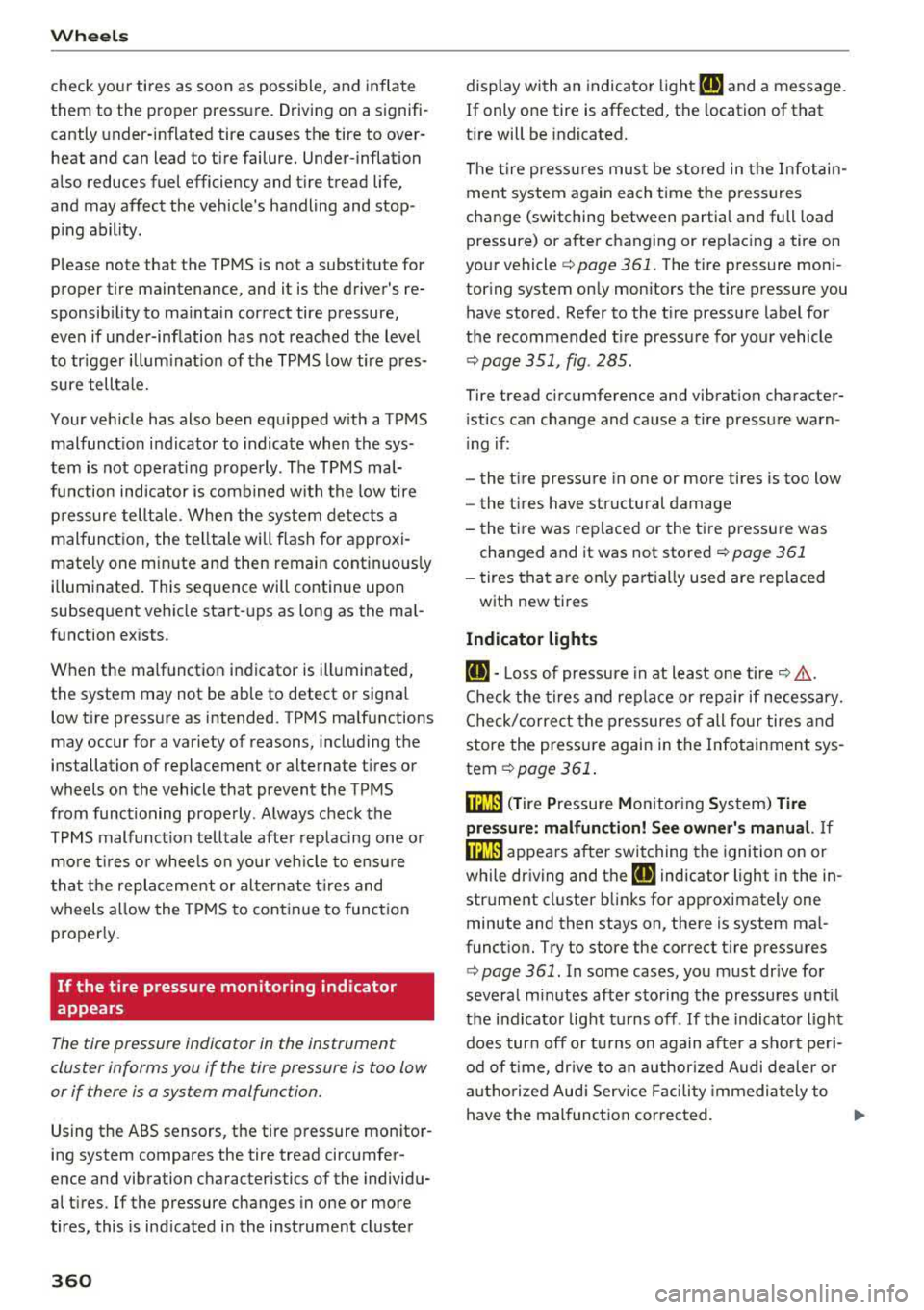
Wheels
check you r tires as soon as possible, and inflate
them to the proper pressure. Driving on a signifi
cantly under-inflated tire causes the tire to over
heat and can lead to t ire failure. Under-inflation
also reduces fuel efficiency and t ire tread life,
a nd may affect the veh icle's handling and stop
p ing ability .
Please note that the TPMS is not a substit ute for
proper tire maintenance, and it is the driver's re
sponsib ility to ma inta in correct tire pressure,
even if under-inflation has not reached the level
to tr igger illum inat io n of the TPMS low tire p res
sure tellta le.
Your veh icle has also bee n eq uipped w ith a TPMS
malfunct ion i nd icator to indicate when the sys
t e m is not operat ing properly. The TPMS ma l
f u nction indicator is comb ined w ith the low tire
p ress ure tellt ale. Whe n the system dete cts a
malfunct ion, the te lltale will flash for approxi
mate ly one min ute and then remain continuo usly
i l luminated. This sequence will continue upon
subseq uent veh icle start- ups as long as the ma l
function ex ists .
When the malf unctio n indicator is ill uminated,
the system may not be able to detect or signa l
low tire pressure as intended . TPMS ma lf u nctions
may occur for a variety of reasons, including the
installation of replacement or alternate t ires or
wheels on the vehicle that prevent the TPMS from functioning prope rly . Always c heck the
TPMS malfunct ion tellta le afte r replacing one o r
mo re t ires o r whee ls on your ve hicle to e nsu re
t hat the repla cement or altern ate t ires and
wheels a llow the TPM S to con tinue to function
p roperly.
If the tire pressure monitoring indicator
appears
The tire pressure indicator in the instrument
cluster informs you if the tire pressure is too low
or if there is a system malfunction .
Using the ABS sensors, the tire pressure mon itor
ing system compares the tire tread circ umfer
ence and vibration cha racteristics of the individu
a l tires. If the pressure changes in one or more
tires, this is ind icated i n the instrument cluste r
360
display with an indicato r light RE and a message .
If only one tire is affected, the location of that
t ir e will be indicated.
The tire press ures mus t be sto red in the Infotain
ment system again each time the p ress ures
c h ange (switching between partia l and full load
pressure) or afte r changing or replac ing a tire on
yo ur vehicle
c:> page 361. The tire p ressure mon i
tor ing system on ly monitors the tire pressure you
have stored . Refer to the t ire pressure label for
t h e recommended t ire pressu re for you r vehicle
<=:> page 351, fig . 285.
Tire tread circumference and vibrat ion characte r
i stics can change and ca use a tire press ure warn
i ng if:
-the t ire pressure in one or more tires is too low
-the t ires have structural damage
-t he t ire was rep laced or the t ire pressu re was
changed and it was not stored
c:> page 361
-tires tha t are o nly p artially used are replaced
with new tires
Indicator lights
RE -Loss of pressure in at least one tire c:> &. .
Check the tir es and rep lace or repair if necessary.
Ch eck/correct the pres sures of all fou r tires and
store the press ure again in the Infotainmen t sys
tem
c:> page 361 .
mm (T ire Pressure Mon itor ing Sys tem) Tire
pressure: malfunction! See owner' s manual.
If
mm appea rs a fter switching the ignition on or
whi le dr iving and the
RE indicator light in the in
strument cl uster bli nks for approximate ly one
minute and then stays on, the re is system ma l
funct ion. T ry to store the correct t ire pressures
c:> page 361. In some cases, you m ust dr ive for
severa l m in utes after sto ring the pressures unt il
the ind icator lig ht turns off . If the indica to r li gh t
does tur n off or turns on again af ter a s hort peri
o d of t ime, dr ive to an author ized Audi dealer or
a uth o riz e d Aud i Serv ice Facili ty immedia tely to
have the mal function cor rected.
IJ,,